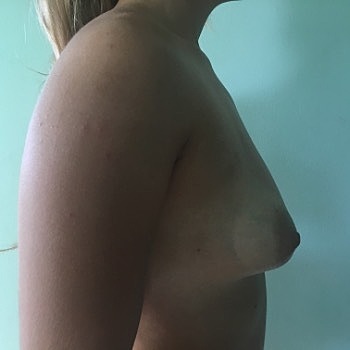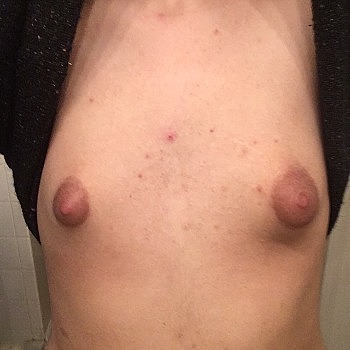What is tuberous breast deformity?
Tuberous breast deformity is a congenital and pathological condition of the breasts. This condition is present at birth and although it can run in families, it is not inherited. There is no uniform medical understanding as to what causes tuberous breast deformity.
As a teenage woman’s breast develops it becomes obvious that there is a constriction and sometimes absence of tissues of the lower pole of the breast. This condition can affect one or both of the breasts. Other medical terms sometimes used include ‘constricted breasts’ or ‘tubular breasts’.
While tuberous breast deformity is harmless, it can result in mild to very severe shape deformity to the breast. The constriction can be mild, and affect only the lower inner aspect of the breast, or it can be severe, and affect the whole lower breast. This deformity results in making the breasts narrow at the chest wall, which gives them a long tubular shape. Breast asymmetry can also occur.
Tuberous breast deformity does not usually affect breast feeding, and does not increase or decrease any risks of future breast disease or breast cancer.
What causes tuberous breasts?
While it is not known exactly why tuberous breasts develop, it is possible to see the changes that occur when tuberous breasts appear. These include:
- The breast being underdeveloped and remaining small.
- Breasts developing in an envelope of fibrous tissue or fascia between the chest skin and its underlying muscles. When this fascia is excessively tight, it restricts the developments of the base of the breast. This restriction usually occurs in the lower part of the breast, resulting in a narrow looking breast with the lower border of the breast sitting quite high.
- Weak fascia developing beneath the areola and nipple. This weak fascia centrally pushes the breast tissue into a small area behind the nipple. Combined with the strong fascia around the margins of the developing breast it stretches the areola to make it look puffy.
Why is tuberous breast deformity an issue?
Tuberous breast deformity becomes obvious during breast development in teenage women. The negative consequences to the shape of the breast can cause great distress.
Typically tuberous breasts are small and pointed in shape and are characterised by:
- Puffy nipples (areolas)
- Small and unevenly developed breasts
- Minimal breast tissue, which sometimes sags
- Triangular shaped, droopy breast tissue
- Nipples that point inwards or downwards
- A higher than normal breast fold
- Constricted lower breast poles
- Wide spacing between the breasts
How is tuberous breast deformity corrected?
While it is possible to correct tuberous breast deformity, because every case of tuberous breast deformity is different the type of treatment recommended will be different for each person. In most cases, the tuberous breast appearance can be dramatically improved by releasing the constrictions responsible for the deformity and inserting appropriate implants.
It is important to do thorough research and consult with Cosmetic Surgeons who have expertise and experience in breast surgery. If you have severe tuberous breast deformity, the breast surgery can be quite complicated. At your Cosmetic Surgeon consultation, the surgeon will examine you, and will also discuss what breast size and shape you would like to have.
The most common tuberous breast correction surgeries include:
What happens during tuberous breast correction surgery?
Tuberous breast correction surgery can involve a number of surgical approaches and techniques. This can include release of constricted tissues, breast implants, fat grafting, repair of a herniated nipple and breast tissue and breast tissue expansion. In severe cases of tuberous breast deformity some patients may need to have two procedures.
Mild cases of tuberous breast deformity can usually be managed with minimal scars that are similar to breast implant surgery scars. In more severe cases, lollipop patterns or periareolar scars on the breast may be required so the symmetry and shape of the breast can be improved.
The most common surgical ways to correct tuberous breast include breast augmentation, also called breast implant surgery and breast tissue expander surgery.
Breast Augmentation surgery to correct tuberous breast deformity
For women who have mild tuberous breast deformity, breast augmentation surgery is an effective to correct this. Breast augmentation can increase the size of the breast tissue, while improving the shape and spacing of the breasts.
It is important to note that every mildly tuberous breast procedure will be treated differently. In some cases a simple breast on a tuberous breast can produce a bad result. With the right surgical expertise, planning and care, it is possible to use breast augmentation to successfully correct tuberous breast deformity.
Your Cosmetic Surgeon can insert the breast implant over your chest muscles. These options will be discussed with you before your surgery. Each technique results in patients having good aesthetic results.
There are various types of breast implant you can choose to reshape and fill-out your breast area. Thy include going from an A or B cup size to a C or D cup size. Some patients choose an implant that gives them a fuller side breast or a more noticeable breast cleavage.
The types of breast implant options you can choose include silicone gel filled or saline breast implants that are round or anatomical, smooth or textured. The implant your Cosmetic Surgeon uses will depend on the type of breast profile and shape you desire. Your Cosmetic Surgeon will customise the breast augmentation surgery so it is proportionate for your physique and looks aesthetically pleasing.
Nipple surgery to correct tuberous breast deformity
If you have nipple surgery it is important to note that a loss of nipple sensation and possible impact on breastfeeding can occur as a result of nipple surgery. While women with tuberous breasts may have issues breast-feeding without surgery, many women can also successfully breast feed after their surgery. At your initial consultation, your Cosmetic Surgeon will discuss your expected outcomes and the possible complications and risks of nipple surgery with you.
Breast Tissue expander surgery to correct tuberous breast deformity
For women with small tuberous breasts to correct tuberous breast deformity, your Cosmetic Surgeon can’t just insert a breast implant. If surgery is to be effective, structural changes need to occur so the breast tissue can expand. It is vital that the skin has been expanded, so the breast implants have an adequate cover of tissue to cover them.
Tissue expanders allow a larger breast implant and will reduce the amount of reshaping required. This technique is ideal for patients who want larger breasts but only have a small amount of tissue to cover the implants. While different Cosmetic Surgeons have different techniques, one technique involves making an incision along the lower edge of the areola (nipple). Through this incision, they will be able to create a wider base for your breast tissue. This process results in the inner edges of your breast being closer together so you have a more natural looking cleavage.
By removing some tissue from the under surface of the breast, tuberous breast deformity can be addressed. When this tissue is removed, it transforms the previously conical shaped, tubular breast into a normal looking breast that has even thickness all around.
Post surgery tuberous breast correction care
After your tuberous breast correction surgery, you will need to wear a surgical compression garment for at least 6 weeks. This will help to support your breasts while helping the healing process.
Most patients take at least 1-2 weeks to recover after tuberous breast augmentation surgery. While gentle exercise can be beneficial, it is usually advised that you also avoid strenuous exercise at least 6 weeks after your surgery.
Because you will not be able to drive for at least 1 week after surgery, it important that you have a support system around you.
Key facts about breast deformity
- Tuberous breast is a distressing breast deformity of unknown cause. This becomes evident in teenage women as their breasts develop.
- It is very treatable by surgery, but if the deformity is severe the surgery can be quite complex.
- Breast implants are often used in the corrective procedures.
- Tuberous breast deformity is not harmful. However, having asymmetrical breasts can be socially limiting and psychologically upsetting. Young women who have breasts developing desire a rounded, natural look that makes them look and feel good.
- Correcting tuberous breast deformity can help improve body image and self-confidence.
Risks and complications of tuberous breast deformity surgery
Any surgical operation brings complications of anaesthesia. Your anaesthetist will be able to discuss with you the possible complications of having an anaesthetic.
General complications of every surgery include:
- Pain. Your healthcare team will give you medication to control the pain. To reduce discomfort and prevent headaches, it’s important that you take the medication.
- Infection of the surgical site (wound). Let your surgeon know if your wounds bleed, swell or become tender. An infection usually settles with antibiotics but you may need another operation.
- Blood clot in your leg (deep-vein thrombosis – DVT). This can cause pain, swelling or redness in your leg, or the veins near the surface of your leg to appear larger than normal. Your healthcare team will assess your risk. They will encourage you to get out of bed soon after the operation and may give you injections, medication, or special stockings to wear. Let the healthcare team know straightaway if you think you might have a DVT.
- Blood clot in your lung (pulmonary embolus). If a blood clot moves through your bloodstream to your lungs. If you become short of breath, feel pain in your chest or upper back, or if you cough up blood, let the healthcare team know straightaway. If you are at home, call an ambulance or go immediately to your nearest Emergency department.
Specific risks and complications of tuberous breast deformity surgery may include:
- With any breast surgery, bruising and swelling must be expected.
- Hematomas, or localised swellings can occur that are filled with blood.
- Capsular contraction that can occur when excessive scar tissue forms around the breast implant. This can lead to a tightening around the implant, resulting
- a change of shape where it becomes firm and becomes painful.
- In some cases, skin necrosis or skin death can occur.
- When incisions are made close to your nipple and areola, a loss of nipple sensation can occur.
- Even with surgery, breast asymmetry may occur.
Find the best tuberous breast deformity Australian Breast Surgeons here.
Important to know
So you can make an informed decision, your elected surgeon will discuss the possible risks associated with tuberous breast correction. Although the majority of patients do not experience these complications, it’s important to understand how they can be managed in the event that they occur.




